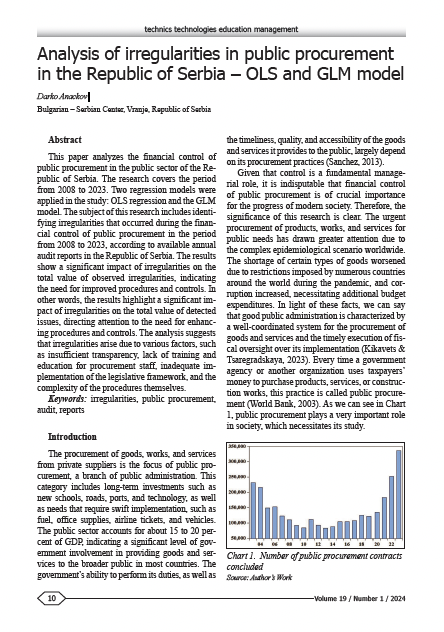Analysis of irregularities in public procurement in the Republic of Serbia – OLS and GLM model
Abstract
_________________________
This paper analyzes the financial control of public procurement in the public sector of the Republic of Serbia. The research covers the period from 2008 to 2023. Two regression models were applied in the study: OLS regression and the GLM model. The subject of this research includes identifying irregularities that occurred during the financial control of public procurement in the period from 2008 to 2023, according to available annual audit reports in the Republic of Serbia. The results show a significant impact of irregularities on the total value of observed irregularities, indicating the need for improved procedures and controls. In other words, the results highlight a significant impact of irregularities on the total value of detected issues, directing attention to the need for enhancing procedures and controls. The analysis suggests that irregularities arise due to various factors, such as insufficient transparency, lack of training and education for procurement staff, inadequate implementation of the legislative framework, and the complexity of the procedures themselves.
Keywords: irregularities, public procurement, audit, reports
References
_________________________
- Abeku, E. E. (2021), The consequences of public procurement and its associated irregularities in Ghana, AARMS–Academic and Applied Research in Military and Public Management Science, 20(1), 55-65.
- Aboelazm, K. S. (2018), Reforming public procurement and public financial management in Africa: Dynamics and influences, Journal of Advances in Management Research.
- Amankwa, M. O., & Tetteh, E. K. (2022), Comparative analysis of public procurement and public financial management within Asia and Africa, International Journal of Procurement Management, 15(2), 133-159.
- Asenso-Boakye, M., & Etse, D. (2014), Irregularities in Ghana’s Public Sector Procurement and Their Possible Reinforcers: A Study of the Auditor General’s Report, International Journal of Economics, Commerce and Management, United Kingdom, 2(2).
- Farahani, H. A., Rahiminezhad, A., & Same, L. (2010), A comparison of partial least squares (PLS) and ordinary least squares (OLS) regressions in predicting of couples mental health based on their communicational patterns, Procedia-Social and Behavioral Sciences, 5, 1459-1463.
- Fazekas, M., & Cingolani, L. (2017), Breaking the cycle? How (not) to use political finance regulations to counter public procurement corruption, Slavonic and East European Review, 95(1), 76-116.
- Field, A. (2000), Discovering statistics using SPSS for windows, London: Sage.
- Gunzynov, Z. P., Dondokova, M. Y., Konovalova, Z. A., Myakhanova, A. N., & Sinkov, D. V. (2022), Legal regulation of procurement activities in Russia, China and Mongolia: some aspects of financial control and anti-corruption, Юридический вестник Самарского университета Juridical Journal of Samara University, 8(1), 88-96.
- Kikavets, V. V., & Tsaregradskaya, Y. K. (2023), Financial control as a factor of effective public procurement management, Law Enforcement Review, vol. 7, no. 2, pp. 85–95. Available at: DOI 10.52468/2542-1514.2023.7(2).85-95 (accessed 15.08.2024.)
- Kozłowski, A. J., & Czaplicka-Kozłowska, I. Z. (2020), Security of Public Financial Resources and the Public Procurement Procedure–Analysis of Transparency and Characteristics of Procedures Based on Research, Internal Security, 12, 129-143
- Lukhele, T. M. (2022), Content analysis and ranking of irregularities in public sector construction procurement in South Africa, International Journal of Construction Supply Chain Management.
- Moran, J. L., Solomon, P. J., Peisach, A. R., & Martin, J. (2007), New models for old questions: generalized linear models for cost prediction, Journal of evaluation in clinical practice, 13(3), 381-389.
- Newman, D., Newman, I., & Salzman, J. (2010), Comparing OLS and HLM models and the questions they answer: Potential concerns for type VI errors, Multiple Linear Regression Viewpoints, 36(1), 1-8.
- Obura, C. O. (2023), Procurement planning: The principle of sound balance between procurement control and achieving value for money, International Academic Journal of Procurement and Supply Chain Management, Volume 3, Issue 2, pp. 19-27.
- Quashie, M. K. (2019), Causes and Costs of Procurement Irregularities in Ghana’s District Assemblies, International Journal of Law and Society, 2(4), 58.
- Sanchez, A. (2013), The role of Procurement, In The International Handbook of Public Financial Management (pp. 312-335), London: Palgrave Macmillan UK.
- Sirotkina, N., & Pavlovskaya, S. (2016), Public control as a mechanism of the openness of public procurement: Case of Russia, Global encyclopedia of public administration, public policy, and governance, Cham: Springer.
- Thai, K. V. (2017), International public procurement: Concepts and practices. In International handbook of public procurement (pp. 1-24), Routledge.
- World Bank. (2003a), Public Procurement Act of Ghana – Country procurement assessment report, Washington D.C. – The World Bank. Report No. 29055. (4). Available at: http://documents.worldbank. org/curated/en/2003/06/3582686/ghana-countryprocurement- assessment- report-vol-4-5-annex- 8-public-procurement-act. (accessed 04.07.2024).
- Državna revizorska institucija. Godišnji izvešaj o radu. Available at: https://www.dri.rs/godisnjiizvestaji- o-radu (accessed 04.07.2024).
Corresponding Author
Darko Anackov,
Bulgarian – Serbian Center,
Vranje,
Republic of Serbia,
E-mail: darko.anackov911@gmail.com

